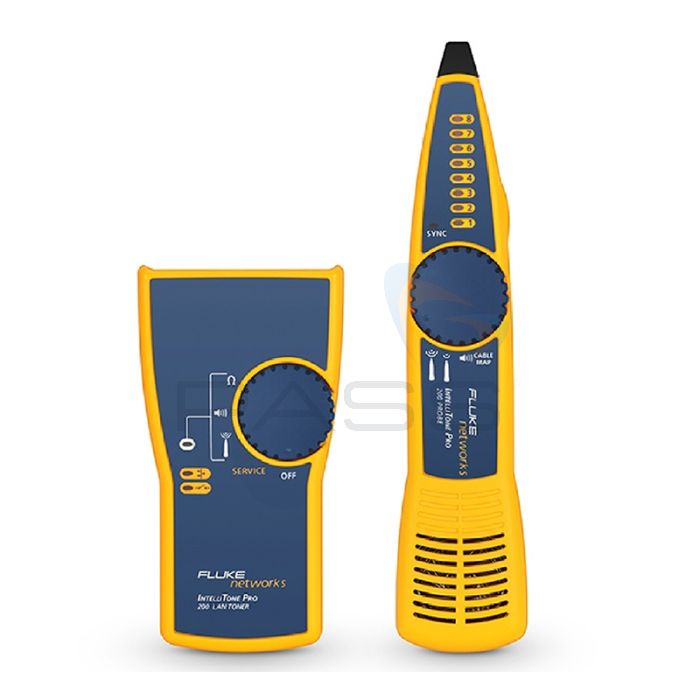Fluke Networks IntelliTone Pro 200 LAN Toner & Probe Kit

- Toner and probe for tracing and locating cables
- Identify specific cables in a bundle or on a patch panel or switch
- Detect faults such as opens, shorts, and reversed pairs
The Fluke Networks IntelliTone Pro 200 LAN Toner & Probe Kit includes a Fluke Networks IntelliTone Pro 200 LAN Toner; Fluke Networks IntelliTone Pro 200 Probe; and a range of accessories. This kit facilitates the tracing and locating of cables allowing you to identify specific cables in a bundle or on a patch panel or switch. Moreover, the Fluke Networks IntelliTone Pro 200 LAN Toner & Probe Kit can detect faults such as opens, shorts, and reversed pairs.
Fluke Networks IntelliTone Pro 200 LAN Toner Overview
The Fluke Networks IntelliTone Pro 200 LAN Toner delivers a stable tone into active network equipment allowing you to:
- Test cable continuity
- Precisely isolate wire pairs using built-in SmartTone analogue toning
- Tone active networks safely and effectively with IntelliTone digital mode
- Identify resistance
- Identify if the digital or analogue tone function is operational
- Identify and diagnose Ethernet link connectivity with NIC/hub indication
It offers four analogue signals which alternate each time a wire pair is shorted.
Additionally, the Fluke Networks IntelliTone Pro 200 LAN Toner includes a cable termination indicator that identifies whether cables are connected. Furthermore, the Fluke Networks IntelliTone Pro 200 LAN Toner will eliminate cable misidentification due to bleed.
Versatility is at the forefront of the Fluke Networks IntelliTone Pro 200 LAN Toner’s design as it supports all VDV cable types (RJ45, RJ11, coax, and bare wire) while banana jacks allow you to use only the leads you need and ensure easy replacement.
Finally, it includes practical features such as a three-level battery status indicator LEDs and an Auto Power Off function which automatically shuts down the Fluke Networks IntelliTone Pro 200 LAN Toner after two and a half hours of inactivity.
Fluke Networks IntelliTone Pro 200 LAN Probe Overview
The Fluke Networks IntelliTone Pro 200 LAN Probe identifies analogue signals issued by the Fluke Networks IntelliTone Pro 200 LAN Toner. A sync LED indicates the detection of the IntelliTone signal and shows the battery status at power-up. A convenient time-saving thumbwheel lets you select desired toning modes via the probe rather than the toner.
Furthermore, multiple-level LEDs simplify signal interpretations in noisy environments. Via these LEDs you can also visually step through wiremap tests; the Fluke Networks IntelliTone Pro 200 LAN Probe works with a CableMap function eliminating the need for a separate wiremap tool.
In addition to this, a Digital Detection mode allows you to locate cables at a distance and isolate cables in bundles or patch panels, while an Analogue mode enables isolation of wire pairs using the SmartTone.
Fluke Networks IntelliTone Pro 200 LAN Toner & Probe Kit Key Features
- Toner and probe for tracing and locating cables
- Identify specific cables in a bundle or on a patch panel or switch
- Detect faults such as opens, shorts, and reversed pairs
- Toner delivers a stable tone into active network equipment
- Toner’s four analogue signals alternate each time a wire pair is shorted
- Test cable continuity
- Precisely isolate wire pairs using built-in SmartTone analogue toning
- Tone active networks safely and effectively with IntelliTone digital mode
- Identify resistance
- Identify if the digital or analogue tone function is operational
- Identify and diagnose Ethernet link connectivity with NIC/hub indication
- Cable termination indicator
- Eliminates cable misidentification due to bleed
- Supports all VDV cable types (RJ45, RJ11, coax, and bare wire)
- Banana jacks
- Three-level battery status indicator LEDs on toner
- Toner automatically powers off after 2.5 hours
- Probe identifies analogue signals issued by the toner
- Sync LED indicates detection of the IntelliTone signal
- Probe shows battery status at power-up
- Multiple-level LEDs simplify signal interpretations in noisy environments
- Visually step through wiremap tests
- Works with CableMap function
- Digital detection mode
- Analogue mode
What’s Included?
- Fluke Networks IntelliTone Pro 200 LAN Toner
- Fluke Networks IntelliTone Pro 200 LAN Probe
- Coax F Connector Adapter
- 2x RJ11 Patch Cables
- 2x RJ45 Patch Cables
- Test Leads with Alligator Clips
- Lanyards
- 2x 9V Batteries
- Quick Start Guide
Offers
 Spend £150+ (Ex VAT) on any qualified Fluke or Beha-Amprobe product(s) and claim a free tool of your choice from the list at Fluke Promotion. Valid February 17 2025 - July 31 2025.
Spend £150+ (Ex VAT) on any qualified Fluke or Beha-Amprobe product(s) and claim a free tool of your choice from the list at Fluke Promotion. Valid February 17 2025 - July 31 2025.
Claims are made direct to Fluke. Terms and conditions apply.
Fluke Networks IntelliTone Pro 200 LAN Toner & Probe Kit Technical Specifications
| General | |
| Operating temperature | 32 °F to 104 °F (0 °C to 40 °C) |
| Storage temperature | -4 °F to +140 °F (-20 °C to +60 °C) |
| Operating relative humidity (% RH without condensation) |
95% (50 °F to 95 °F; 10 °C to 35 °C) 75% (95 °F to 104 °F; 35 °C to 40 °C) Uncontrolled < 50 °F (< 10 °C) |
| Vibration | Random, 2 g, 5 Hz – 500 Hz |
| Shock | 1 m drop test with and without module |
| Safety | IEC 61010 Category: None |
| Altitude | 3000 m |
| EMC | EN 61326-1 |
| Battery type and life | 9 V alkaline (NEDA 1604A or IEC 6LR61); 20 hours typical |
| Applications | Copper cabling media, including shielded (STP) and UTP cable; 75 or 50 Ohm coaxial cable; two conductor control, security, generic cabling. 10 Base-T or 10/100/1000 Base-T datacom networks. |
| Toner | |
| Dimensions | 5.54 in x 2.94 in x 1.25 in (14.1 cm x 7.5 cm x 3.2 cm) |
| Display | LED |
| Control | Thumbwheel switch |
| Toner interface | Main Mod8 port for tone generation on all 4 pairs of UTP / STP cabling, F connector for coaxial cabling, Banana jack plugs (2) - two conductor wiring |
| Toner frequency | IntelliTone™ signal: encoded digital signal Analog SmartTone signal: 500-1200Hz, 4 Songs |
| Output power | 5 V p-p |
| Auto power down | Turns off automatically after 2.5 hours of inactivity |
| Probe | |
| Dimensions | 8.73 in x 1.88 in x 1.26 in (22.2 cm x 4.8 cm x 3.2 cm) |
| Display | (8) LED indicators, Synch LED indicator |
| Audio | IntelliTone: Microprocessor controlled audio files, Analog: Detected toner signal |
| Control | Thumbwheel switch, volume control wheel |
| Tone detection | Detects IntelliTone™ digital signal for Locate, Isolate and CableMap Detects Analog SmartTone Signal (500-1200Hz) and other analog toners. |
| Toner interface | Main Mod8 port for cablemap on all four pairs of UTP / STP cabling |
| Auto power down | Turns off automatically after one hour of inactivity |




